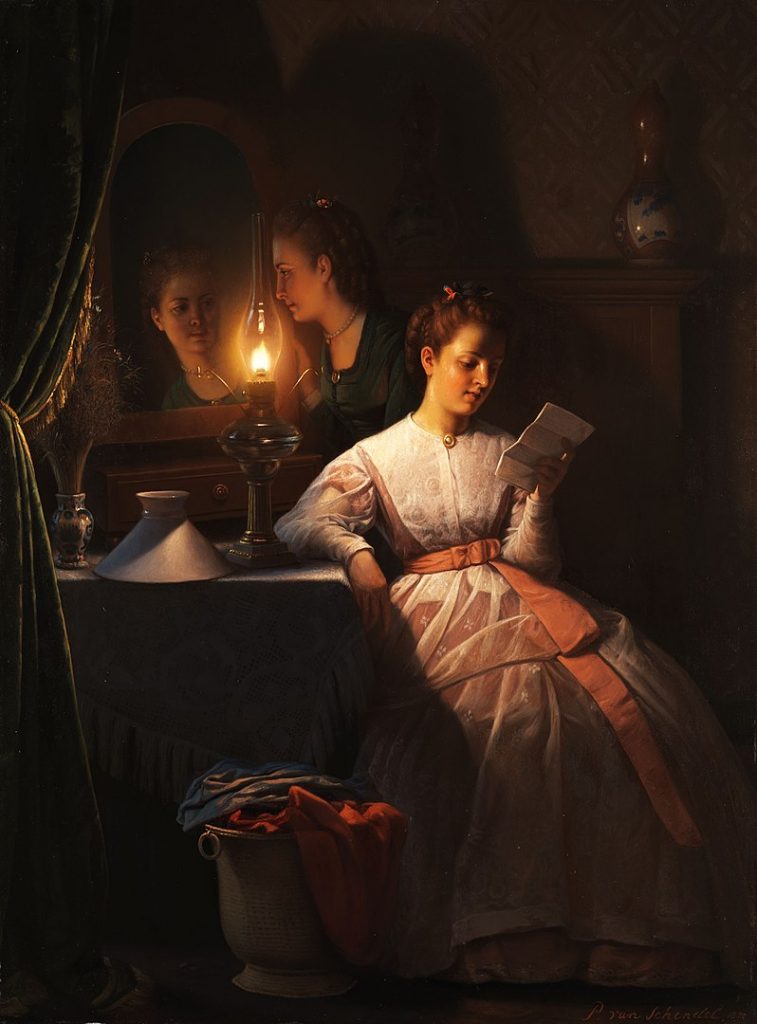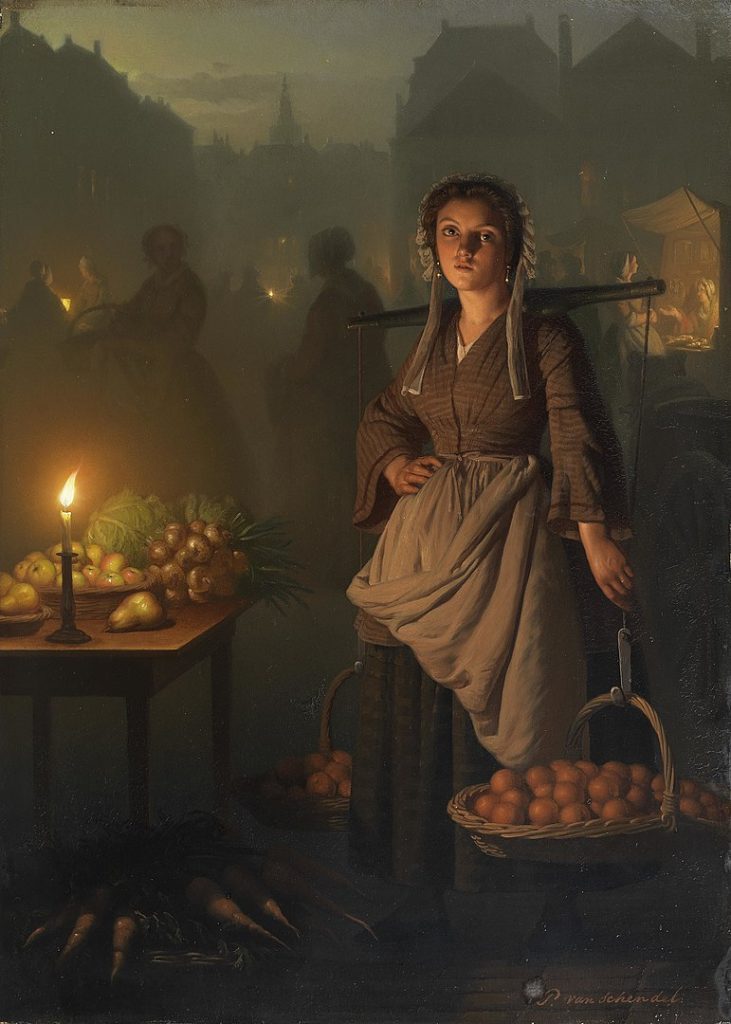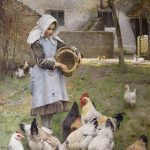
Petrus van Schendel, a Dutch-Belgian painter of the 19th century, remains celebrated for his mesmerizing candlelight paintings. These works, characterized by their rich contrasts of light and shadow, captured the imagination of audiences across Europe. Van Schendel’s art exemplified the Romantic ideals of beauty, emotion, and mystery, offering an enchanting glimpse into everyday life illuminated by the warm glow of artificial light. This article explores the life, career, and enduring legacy of this remarkable artist, whose works bridged the Dutch Golden Age tradition and the Romantic movement.
With a mastery of chiaroscuro—an artistic technique that juxtaposes light and shadow—Van Schendel elevated mundane scenes to extraordinary, timeless compositions. From bustling night markets to serene domestic interiors, his art drew viewers into a world of luminous detail and emotional depth. Although his fame waned during his later years, his works experienced a revival in the modern era, earning him a well-deserved place among history’s greatest painters. This biography takes you through his life story, from his early days in the Netherlands to his success in Belgium, uncovering the themes and techniques that defined his oeuvre. Join us on this journey into the captivating world of Petrus van Schendel, the master of candlelight.
Early Life and Education
Petrus van Schendel was born on April 21, 1806, in the small village of Terheijden in the Netherlands. His father, Johannes van Schendel, was a carpenter, and his family lived a modest life in this rural community. From an early age, Petrus displayed a talent for drawing and painting, often sketching scenes from his everyday surroundings. His parents supported his artistic interests, recognizing his potential and encouraging him to pursue formal education in the arts.

At the age of 16, Van Schendel enrolled at the prestigious Royal Academy of Fine Arts in Antwerp. There, he studied under the prominent artist Mattheus Ignatius van Bree, a key figure in the Romantic movement. Van Bree’s influence was instrumental in shaping Van Schendel’s artistic vision, particularly his attention to dramatic lighting and atmospheric effects. During his time at the academy, Petrus honed his technical skills, mastering the fundamentals of composition, anatomy, and perspective.
Despite his young age, Van Schendel’s talent stood out among his peers, earning him recognition and accolades. His early works, though modest in subject matter, hinted at the brilliance that would define his later career. These formative years were a period of intense learning and experimentation, laying the foundation for his future success. He graduated from the academy with honors, equipped with the skills and ambition to make his mark in the art world.
After completing his education, Van Schendel began his career as a painter, focusing initially on portraiture and landscapes. These early works reflected his academic training and Romantic sensibilities but lacked the distinctive qualities that would later define his signature style. It was during this time that he began to explore the effects of light and shadow, experimenting with ways to create atmosphere and mood. This experimentation would eventually lead to the development of his unique candlelight genre, setting him apart from his contemporaries.
Development of the Candlelight Genre
Van Schendel’s candlelight paintings, also known as nocturnal scenes, became his defining artistic achievement. His fascination with the interplay of light and shadow led him to develop a unique style that focused on artificial light sources, such as candles and lanterns. These light sources served as both the literal and metaphorical center of his compositions, casting a warm glow that illuminated the surrounding figures and objects. His mastery of chiaroscuro created a striking contrast between the light and the enveloping darkness, drawing viewers into the intimate world of his paintings.

The inspiration for Van Schendel’s candlelight works can be traced back to the Dutch Golden Age, particularly the works of Rembrandt and Gerard Dou. These earlier artists had pioneered the use of dramatic lighting effects, which Van Schendel adapted and refined for his own purposes. Unlike his predecessors, however, Van Schendel focused on scenes of everyday life, such as bustling night markets, quiet interiors, and religious gatherings. His ability to combine technical precision with emotional resonance made his works deeply engaging and accessible to a wide audience.
Van Schendel’s market scenes, in particular, became a hallmark of his oeuvre. These paintings often depicted lively, crowded marketplaces illuminated by the flickering glow of candles and lanterns. The figures in these scenes were rendered with exquisite detail, from the vendors selling their wares to the customers engaged in animated conversations. The light sources not only highlighted the central figures but also created a sense of depth and atmosphere, transforming ordinary scenes into magical, almost theatrical settings.
As his candlelight paintings gained popularity, Van Schendel became one of the most sought-after artists of his time. Collectors and patrons across Europe admired his ability to capture the beauty and mystery of light, earning him commissions and invitations to prestigious exhibitions. His works were showcased in Paris, London, and Amsterdam, where they were met with critical acclaim. This period marked the height of his career, as he solidified his reputation as a master of the Romantic style.
Life in Belgium: Artistic Success and Personal Life
In search of greater opportunities, Van Schendel relocated to Belgium, a move that would prove pivotal for his career. He initially settled in Brussels, where he quickly established himself as a leading artist in the city’s vibrant art scene. The move allowed him to connect with wealthy patrons, who commissioned works for their private collections. It was during this time that he began producing some of his most famous candlelight paintings, which were widely exhibited and celebrated.

While Van Schendel’s professional life flourished, his personal life was equally eventful. He married Maria Joanna van Stappen, with whom he had a large family. Despite his demanding career, he remained devoted to his wife and children, often incorporating scenes of domestic life into his paintings. His family provided him with a sense of stability and inspiration, influencing the warm, intimate quality of many of his works.
The social and economic context of the mid-19th century played a significant role in shaping Van Schendel’s art. The Industrial Revolution was transforming European society, creating a growing middle class with an appetite for art that reflected their values and aspirations. Van Schendel’s works, with their emphasis on beauty, emotion, and everyday life, resonated deeply with this audience. His market scenes, in particular, captured the bustling energy of urban life while offering a nostalgic glimpse of simpler, pre-industrial times.
Despite his success, Van Schendel remained humble and dedicated to his craft. He continued to experiment with new techniques and themes, always seeking to refine his artistic vision. His time in Belgium marked the peak of his career, as he balanced professional acclaim with a fulfilling personal life. However, the changing tides of the art world would soon present new challenges, leading to a period of decline in his later years.
Themes and Symbolism in Van Schendel’s Art
Van Schendel’s art is rich with themes and symbolism, offering layers of meaning that extend beyond their visual appeal. One of the most prominent themes in his work is the interplay between light and darkness, which serves as a metaphor for hope, divinity, and the human condition. The candles and lanterns in his paintings often symbolize enlightenment and spiritual guidance, casting their glow as a beacon of warmth and reassurance. This subtle religious undertone reflects Van Schendel’s Romantic sensibilities and his interest in exploring the deeper truths of human existence.

Another recurring theme in Van Schendel’s art is the celebration of everyday life. His market scenes, domestic interiors, and religious gatherings elevate ordinary moments to extraordinary levels of beauty and significance. By focusing on the intimate details of these scenes, Van Schendel invites viewers to appreciate the simple joys and quiet moments of life. This Romantic ideal of finding beauty in the mundane is a hallmark of his work, resonating with audiences both in his time and today.
Van Schendel’s technical mastery is another key element of his artistic legacy. His use of chiaroscuro not only creates a sense of depth and atmosphere but also directs the viewer’s attention to the most important elements of the composition. His brushwork is precise yet fluid, capturing the textures of fabric, the flicker of a candle, and the expressions of his figures with remarkable realism. This attention to detail enhances the emotional impact of his paintings, making them deeply engaging and memorable.
The symbolic depth of Van Schendel’s art is further enhanced by his use of recurring motifs and visual cues. For example, the inclusion of children, animals, and market goods often adds layers of narrative and meaning to his scenes. These elements, combined with his masterful use of light, create compositions that are both visually stunning and rich with interpretive possibilities. Van Schendel’s ability to balance technical precision with symbolic resonance is a testament to his genius as an artist.
Decline and Later Years
As the 19th century progressed, the art world began to shift away from Romanticism toward new movements like Realism and Impressionism. This change in artistic trends posed a significant challenge for Van Schendel, whose candlelight paintings were rooted in the Romantic tradition. The growing emphasis on naturalism and modernity left little room for his idealized, atmospheric works, leading to a decline in demand for his art. Despite his best efforts to adapt, Van Schendel struggled to maintain his prominence in an evolving cultural landscape.
In addition to professional challenges, Van Schendel faced personal difficulties during his later years. Health issues began to take a toll on his ability to work, limiting his productivity and further diminishing his income. Financial struggles compounded his difficulties, as the declining popularity of his paintings left him with fewer opportunities for commissions. These hardships marked a stark contrast to the success and acclaim he had enjoyed earlier in his career.
Van Schendel’s final years were marked by a quiet withdrawal from the public eye. He continued to paint, albeit on a smaller scale, focusing on works that reflected his personal interests rather than market demands. Despite the challenges he faced, he remained committed to his artistic vision, producing paintings that retained the beauty and emotional depth for which he was known. His resilience and dedication to his craft are a testament to his enduring passion for art.
Petrus van Schendel passed away on December 28, 1870, in Brussels, Belgium. Though his later years were marked by struggle, his contributions to the art world left an indelible mark on the history of Romanticism. His candlelight paintings, with their unique blend of technical mastery and emotional resonance, continue to captivate audiences to this day. His legacy serves as a reminder of the enduring power of art to illuminate the human experience.
Posthumous Recognition and Influence
After his death, Van Schendel’s work fell into relative obscurity as new artistic movements dominated the cultural landscape. However, the 20th and 21st centuries saw a renewed interest in his paintings, as art historians and collectors rediscovered the beauty and technical brilliance of his candlelight scenes. Today, his works are celebrated in major art museums and private collections around the world, where they continue to inspire awe and admiration. This revival has solidified his place as one of the most important painters of his era.
Van Schendel’s influence can be seen in the works of later artists who explored the use of light and shadow. His mastery of chiaroscuro has served as a source of inspiration for painters and photographers alike, who seek to capture the same sense of atmosphere and emotion. His unique approach to nocturnal scenes has also contributed to the broader understanding of light as a central element in art. In this way, his legacy extends far beyond his own body of work.
The cultural significance of Van Schendel’s art lies in its ability to bridge different artistic traditions. By combining the technical precision of the Dutch Golden Age with the emotional depth of Romanticism, he created a style that is both timeless and uniquely his own. His works offer a glimpse into a world that is both nostalgic and universal, reminding viewers of the beauty and mystery of everyday life. This enduring appeal has made him a favorite among art enthusiasts and scholars alike.
In recent years, Van Schendel’s candlelight paintings have become highly sought after in the art market, with collectors paying premium prices for his works. This renewed interest is a testament to the lasting impact of his art, which continues to resonate with audiences across generations. As the world grows increasingly fast-paced and modern, his paintings offer a moment of reflection and wonder, inviting us to step into a world illuminated by the soft glow of candlelight.
Key Takeaways
- Petrus van Schendel is renowned for his candlelight paintings that masterfully use chiaroscuro.
- He studied at the Royal Academy of Fine Arts in Antwerp under Mattheus van Bree.
- His works often depict bustling night markets and domestic scenes lit by candles and lanterns.
- Although his popularity declined during his later years, his art saw a revival in the modern era.
- Van Schendel’s legacy bridges the Dutch Golden Age and Romanticism, inspiring artists who explore light and shadow.
FAQs
- Who was Petrus van Schendel?
He was a 19th-century Dutch-Belgian painter known for his candlelight paintings and mastery of chiaroscuro. - What was his signature style?
Van Schendel specialized in nocturnal scenes illuminated by artificial light sources, like candles and lanterns. - Where did Van Schendel study art?
He studied at the Royal Academy of Fine Arts in Antwerp under Mattheus Ignatius van Bree. - Why did his popularity decline?
Changes in artistic trends toward Realism and Impressionism diminished the demand for his Romantic works. - What is Petrus van Schendel’s legacy today?
His works are celebrated for their technical brilliance and emotional depth, continuing to inspire artists and collectors alike.




